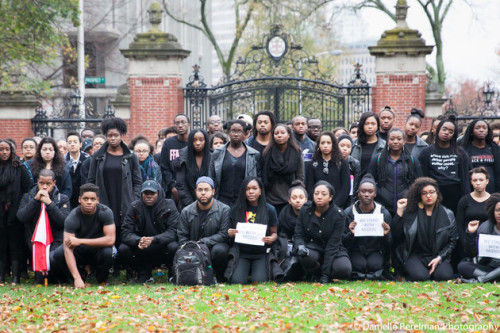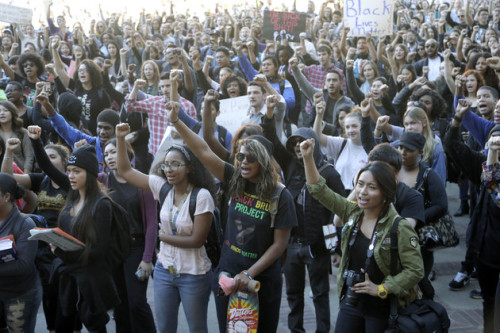
Students at Boston College raise their arms during a solidarity demonstration on the school’s campus. (AP Photo/Steven Senne)
If there’s one thing University of Missouri senior Alanna Diggs thinks people are getting wrong about campus racism protests, it’s the assumption that they’re something new.
The demonstrations at Mizzou this month...partly over how they handled various racist incidents on campus…were not a result of spontaneous combustion.”
“It was not an overdramatic reaction by a couple of angry black students, but a moment built up over time…any of us behind the scenes have been suffering…while trying to deal with class and work. The movement is not over. This is the beginning.”
The demonstrations at Mizzou’s campus in Columbia came on the heels of unrestat Yale University, and have been copied…at dozens of other colleges…
Protests staged on college campuses last week are the culmination of years of activism around inequality and everyday racism... The demands activists are making are reminiscent of similar protests decades earlier. And scholars caution…improving racial tensions on campuses will likely take years.
“What we are seeing is the beginning of a movement where students…are finding the courage to speak up about what they have been experiencing,” said Yolanda Sealey-Ruiz…”I think Mizzou is a catalyst, an inspiration perhaps, but not a one-off event. I think we are also witnessing a reprise to history — college campuses have historically been places where protest to inequality has taken place.”
Students are arriving on campus believing racism remains persistent in America today. According to an annual survey...the percentage of students who believe racism is no longer an issue has risen slowly over 25 years, from 19 percent in 1990 to 24 percent in 2015.

Student activists at Brown University pose for a photo. (Photo credit: Danielle Perelman)
Students of color who’ve spoken with HuffPost say that does not surprise them, given that students are growing up witnessing high-profile deaths of unarmed black men and teens…Those experiences are coupled multiple examples of fraternity and sorority parties featuring black face and caricatures of various ethnic groups, while Muslim students at some campuses have been subjected to spying by law enforcement.
“We’re not that much that different than the people being killed,” said Taylor Lemmons, a junior at Claremont McKenna College. “Just because we’re going to get a degree…doesn’t mean we’re that much different…”
More selective colleges are still disproportionately white compared with the general population…Black students are less likely to graduate within six years compared with their classmates…
“It’s the responsibility of every institution to…have as many ongoing conversations as possible, to create forums, to use every resource they have from the president to the students themselves,” Bial said. “And the conversation shouldn’t just be happening one time.”
Activists also are demanding changes to curriculum to address diversity and an administrative acknowledgement of barriers that students of color face…
Reine Ibala, a senior at Yale, described either feeling “invisible” on campus, or like she was an intruder and couldn’t rely on bystanders to help if something happened.
“The thing about being black on a college campus in an urban area is that your color…at times puts my status as a student in question,” Ibala said…
Students protesting on campuses told HuffPost their demonstrations were not simply about offensive Halloween costumes, misguided emails from administrators or one person shouting the N-word. The emotional response…comes from dealing with years of feeling like administrators aren’t trying to make things better for them…

University California Los Angeles students stage a protest rally in a show of solidarity with protesters at the University of Missouri. (AP Photo/Nick Ut)
Transparency during the next steps will be critical, said Reese, president of National Association of Diversity Officers in Higher Education. Reese recommended including students in assessing what steps a college will take to address racial issues…
But in the near term, both Reese and Bial emphasized that colleges will have to be quicker to respond to individual incidents of racism.
“It’s important to say this happened and we’re not okay with it, and it’s important for students to say it as well — I can’t emphasize that enough,” Bial said. “Students can’t give up the power they have to voice opinions about what’s okay and what’s not okay.”
Vernā Myers, a diversity consultant and author, said now that Mizzou has served as a spark, protests against campus racism won’t go away.
“This generation didn’t think they’d have to go through something like this,” Myers said. But now, they are empowered to do so, and “they’re going to help our country live up to what we say we believe.”
Read the full article here.












Comments Are Welcome
Note: We moderate submissions in order to create a space for meaningful dialogue, a space where museum visitors – adults and youth –– can exchange informed, thoughtful, and relevant comments that add value to our exhibits.
Racial slurs, personal attacks, obscenity, profanity, and SHOUTING do not meet the above standard. Such comments are posted in the exhibit Hateful Speech. Commercial promotions, impersonations, and incoherent comments likewise fail to meet our goals, so will not be posted. Submissions longer than 120 words will be shortened.
See our full Comments Policy here.